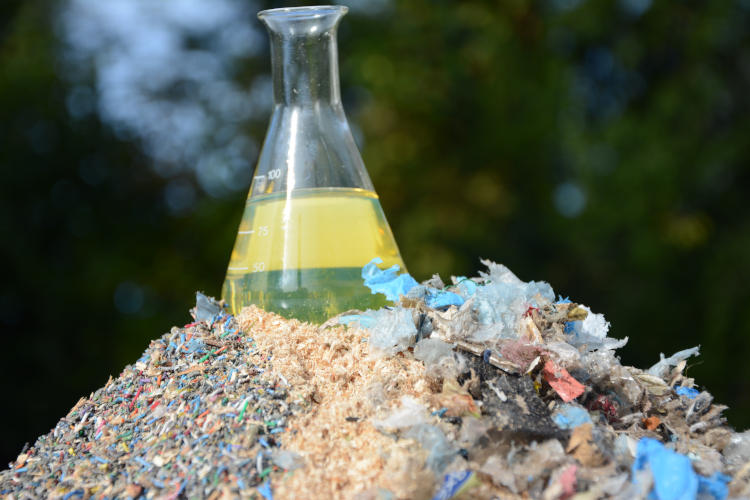Material recovery and energy recovery are the two main process types used in plastics recovery. Mechanical recycling and feedstock recycling are the two main material recovery areas. Post-use plastics are reprocessed by mechanical recycling into plastic recyclates or secondary plastic products. In a broader context, feedstock refers to the raw materials or substances that are utilised in industrial processes, especially those that are transformed into final goods.
Feedstocks
Feedstock is essentially the starting point for manufacturing or production. Materials like plastic trash, biomass, or other recyclables that may be utilised as input for different recycling and conversion technologies to create new goods or energy sources are referred to as “feedstock.”
Feedstock recycling, sometimes referred to as chemical recycling, is the process that converts plastics back to basic petrochemical feedstocks for use by industry in the form of Synthetic crude, process chemicals, or fuels.
Feedstock recycling
Feedstock recycling, often referred to as tertiary or chemical recycling, is the process of turning discarded polymers back into their original monomers or other useful compounds. These products can be used as fuel for vehicles or as feedstock for a range of downstream industrial operations.
The goal of feedstock recycling techniques is to produce high-quality raw materials that may be used to make new plastic goods, as compared to typical mechanical recycling, which frequently produces lower-quality plastics.
Key aspects of feedstock recycling include:
- Chemical Processes: To depolymerize plastic waste, feedstock recycling uses a variety of chemical processes. Depolymerization, pyrolysis, solvolysis, and gasification are a few examples of these procedures.
- Monomer Recovery: Recovering monomers or other useful chemicals from polymers is the main objective. monomers are the fundamental elements of plastics. it can be possible to recycle them and create premium polymers.
- High-Quality Output: Compared to mechanically recycled plastics, the feedstock produced by these processes is usually of higher quality, making it appropriate for a larger variety of applications.
- Diverse Plastic Types: A wide range of plastics, including mixed plastics and polluted materials, can be recycled using feedstock.
- Environmental Benefits: Feedstock recycling can lessen the demand for new plastic manufacturing and lessen the environmental effect of plastic pollution by converting plastic waste into useful resources.
Feedstock recycling technology in sustainable recycling Process
feedstock recycling provides a solution to the resource- and environmental-related problems connected with traditional recycling and waste management; it is regarded as a technique in sustainable recycling.
Here’s how feedstock recycling technology contributes to sustainable recycling:
- Plastic waste management: Recycling feedstock can help keep plastic waste away from garbage dumps and reduce the harm that plastic pollution causes to the environment.
- Resource conservation: Feedstock recycling allows the recovery of valuable materials from mixed or contaminated waste streams that would otherwise be challenging to recycle. This reduces the need for extracting new raw materials, conserving natural resources and reducing the environmental impact of mining and extraction.
- waste reduction: Feedstock recycling can assist in lowering the amount of trash transported to landfills or incinerators by turning waste materials into valuable feedstocks or energy sources. This reduces the risks to the environment and human health that come with burning and disposing of waste in landfills.
- Energy recovery: Non-recyclable materials can be turned into alternative fuels or energy, such as heat or electricity, using feedstock recycling procedures. In addition to lowering the need for fossil fuels, energy recovery also helps provide cleaner energy, which lowers greenhouse gas emissions.
- Pollution reduction in the environment: Feedstock recycling helps reduce pollution by rerouting waste materials away from unregulated disposal techniques or open dumping. By doing this, toxic compounds can be kept from leaking into the environment, enhancing their general quality.
Feedstock recycling technologies play a crucial role in the sustainable recycling of plastics from end-of-life electrical and electronic products. These technologies aim to convert plastic waste into valuable feedstock materials, which can be used to produce new plastic products. Some common feedstock recycling methods for plastics in electronic waste include:
Pyrolysis: Pyrolysis is the process of thermally breaking down plastic waste to recover materials that may be used in the production of new plastics, replacing virgin plastic feedstocks. Using this technique, a variety of biomass materials, including wood, crop leftovers, and even plastic trash, may be transformed into useful goods like biofuels, charcoal, and chemical feedstocks.
Like other sustainable recycling techniques, pyrolysis establishes a connection between waste management and new manufacturing activities, thereby forming a link in the circular economy value chain. Based on this study, pyrolysis recyclers require well-sorted, clean, and largely homogeneous feedstock comprising about 85% polyethylene (PE) and polypropylene (PP).
Pyrolysis is a versatile technique that can help with environmental preservation, renewable energy generation, and sustainable waste management.
Gasification is a process where mixed waste materials are heated to a very high temperature in the presence of a limited amount of oxygen. which breaks the molecules down to their simplest components to produce syngas (a mix of hydrogen, carbon monoxide and some carbon dioxide). The syngas can then be used to produce a variety of chemicals (e.g., methanol, ammonia, hydrocarbons, acetic acid) for plastics production as well as fuel and fertilizer.
Gasification provides an effective means of obtaining energy from a variety of feedstocks while reducing greenhouse gas emissions and other pollutants, it is seen as an ecologically beneficial technique. To achieve the best outcomes, the process must be carefully controlled and managed, and the economic feasibility of this approach may differ based on the particular feedstock and application.
Chemical Recycling: Plastics may be broken down into their monomeric components using a variety of chemical processes, including solvolysis and depolymerization. Then, new polymers can be made using these monomers.
Solvent-Based Recycling: In certain technologies, various plastic types are dissolved and separated using solvents, which makes it possible to recover pure polymers.
Biological Recycling: Certain polymers, such as polyesters, may be broken down into biodegradable components by using enzymes or microbes.
These feedstock recycling methods are more sustainable than traditional mechanical recycling processes, as they allow a wider range of plastics to be reused, reducing the need for new fossil-based feedstock, and can address the challenges posed by mixed plastic waste streams.
To optimize their sustainability in the recycling of electronic devices, they may need additional research and integration into the current recycling infrastructure. However, they also present unique technical and financial hurdles.
- About the Author
- Latest Posts
A passionate advocate for all natural and sustainable ideas. With a background in sustainable economics science and a deep love for nature, Sojy has dedicated his career to promoting eco-friendly practices and encouraging others to live a more sustainable lifestyle. He is an avid hiker, gardener, and cook, and loves experimenting with natural ingredients in his recipes and lifestyle routines. Sojy believes that small changes can make a big impact and is constantly seeking out new ways to reduce his carbon footprint and inspire others to do the same




